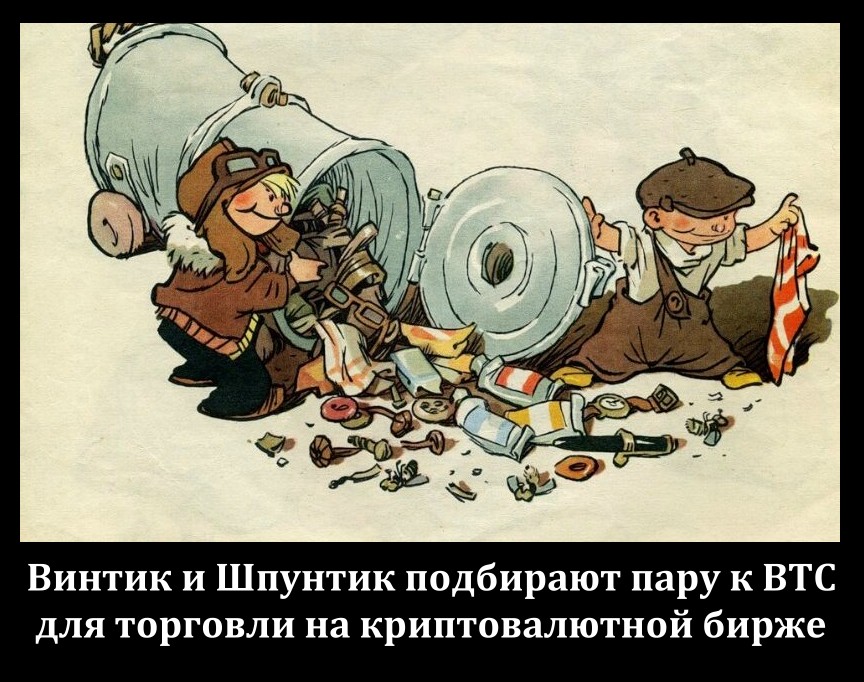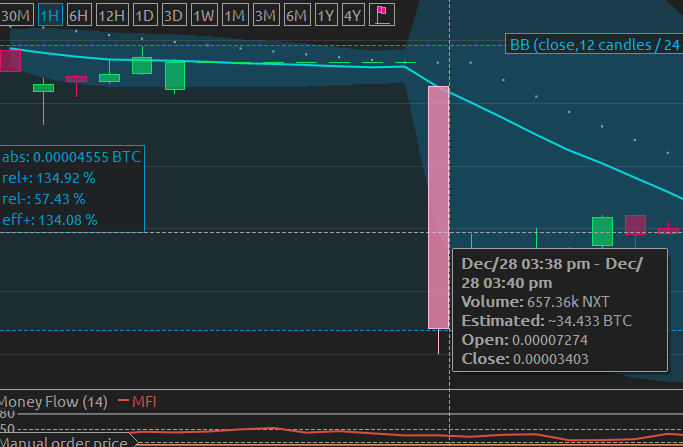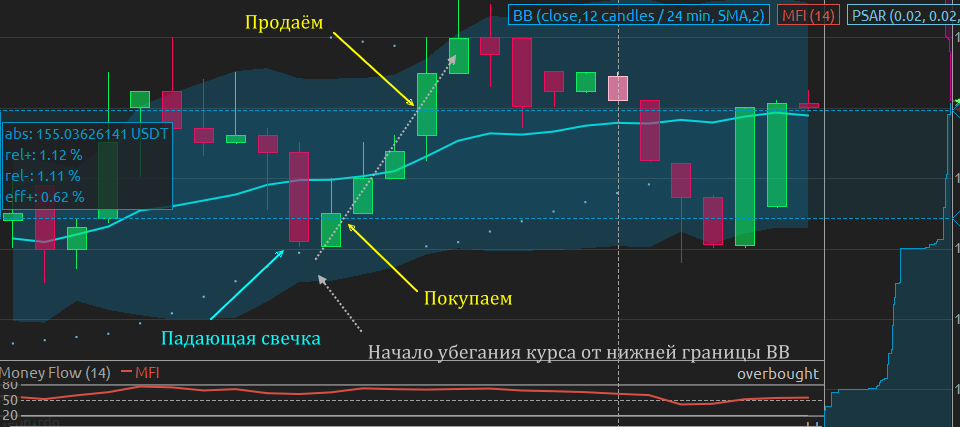
Once I felt like a flying floor from the 20th to the asphalt pavement. But for some reason I flew calmly, periodically tugging at my perfectly fitting suit and focusedly throwing coins from my pocket in the direction of asphalt, probably to reduce the speed of the fall. As a result, the asphalt of course caught up with me, I bumped into it with my nose, woke up and realized that after a certain period of speculation with air on cryptocurrency exchanges, I apnul new ranks of several traits at once. The calm became icy, the endurance of the beyond, and the hope of a hopeless, indestructible. In general, I used to be a rather phlegmatic and cold-blooded type, for which I earned a strange nickname “Nord” among my colleagues (I don’t know how the brand of refrigerators is connected, but they say that they called it for him). But in recent years I have surpassed myself, but apparently the ideal is no longer that far.
Such a strange introduction was written because I am convinced that exchange trading, and especially trading with frank garbage (altcoins), does not tolerate impetuous, enthusiastic, gambling and unseasoned people.
So the very first and preliminary advice: if you feel at least one of these character traits in yourself, then do not even begin. Well, or do not listen to various incomprehensible advisers and throw under the cut without looking.
Since our instruction is for the smallest traders, let's start from the very beginning.
1. Do not buy cryptocurrency in exchange offices
The main mistake of the first step for novice traders is an attempt to buy bitcoins through exchangers. This mistake is quite funny and childish, but almost all my friends attacked this rake.
Remember: There are many exchanges on the network that allow you to replenish trade wallets with fiat funds, without requiring any verification. And some of them (offhand livecoin.net and yobit.net) Allow you to even enter rubles through the QIWI system. The percentage of this is low (and sometimes completely zero) and in any case it is lower than the percentage in exchange offices, which, moreover, are often asked to send them passport and credit card photos.
Conclusion: Cheats that tear up exchangers are unreasonably high, and the risks of depositing money into the system through small exchanges are comparable to the risks associated with exchangers. Plus, providing your passport data to strangers contradicts the basic principles of both network and offline security.
2. Carefully choose the exchange for trading
Suppose you read a lot of articles about candlesticks, Bollinger bands, margin trading, etc. (By the way, preliminary reading would have to be put as zero, but this is an obligatory, understandable thing for everyone and we don’t even mention it), replenished your wallet somewhere on Livecoin or Fuck, want to start trading, start earning your 40% a day and burn away with impatience.
But after some time, it turns out that trading on small and not widely promoted exchanges is rather sluggish, and price hikes do not fit into any of the same bands.
Remember: small exchanges are unpredictable, unreliable, are often used in the Telegram network for pamps (we already got acquainted with the main materiel and know what it is), the main profits are received from frank lotteries like Dice, and trading on such exchanges is dull, but demanding quick response and self-denial. Normal, honest traders rarely linger on such exchanges and after a while switch to a larger and more reliable exchange, of which there are only a few.
We briefly list the main ones in the order of my personal and subjective attitude towards them. Considering worthy of mentioning only candidates with a very large volume of trades and constantly present motion, allowing to play on a sinusoid. The trading volume and the involvement of the mass of traders allows us to hope for a minimal likelihood of these exchanges collapsing.
1. BittrexIt was my second favorite exchange, but because of the new policy BitFinex came out on top. It features an increased commission of% 0.25 for each transaction and a raised bar of minimum transactions (now around $ 14). In terms of the number of trading pairs (269), it holds first place in the top ten of the stock exchanges in terms of trading volume.
To withdraw funds, mandatory verification is required, which is also very complex and can take up to a month. Moreover, users from Russia do not like (probably there is something for that) and do not even want to remember how much time and nerves the Enhanced status there cost me.
2. BinanceVery nice exchange. Just a smart browser interface (which doesn't work in Firefox), a surprisingly low commission (0.05% for a deal and at least a market for withdrawal) and a large number of pairs. The amount of input is not limited by anything, and you can output up to 2 BTC per day. Among the shortcomings, we can note a small number of decimal places at stakes and the complexity of verification, which is necessary for working with fiat funds and for outputting more than 2 BTC. Without a passport and a good command of the language there is nothing to do. I just verified “shob bulo” and this happened only after two weeks of hanging the ticket in technical support and talking on Skype with the camera on.
An unpleasant feature of this exchange are tails that hang on wallets. Suppose that we bought 0.02 of some kind of coin (only 2 decimal places are available when betting). After buying on the balance of the purse of this coin is 0.0199900049975 units. After that, we can only sell 0.01, and the rest of the tail will hang on the wallet without the possibility of selling or withdrawing. The standard solution to this problem is to buy BNB coins and install in the commission payment profile using BNB. In this case, when buying 0.02 units of something, but the wallet will come the same 0.02, and the commission will be charged to the BNB wallet. But here there are pitfalls. The minimum amount of the purchase or sale of BNB is 5 coins (about $ 100) and it turns out that for a minimally comfortable trade, an initial payment of $ 100 is needed, which can no longer be used for trading.
3. Bitfinexupd: In the new year for new accounts on this exchange have imposed a limit of $ 10,000 in the account. For beginning traders, this is a bit too much and we cross out the list in this article.
It was my favorite exchange. Many currency pairs, allows you to enter and display any cryptocurrency without verifying the identity. Commission is acceptable (0.2%). The input volume is not limited by anything, but you can output with a minimum one-time amount equivalent to $ 250. Browser shopping interface is great. The difficulty lies in the verification, which is necessary for trading fiatnym funds and (according to rumors) reduces the likelihood of an account being banned for no particular reason, but Bitfinex, in principle, does not often ban banet. I have not completed this quest, but I have no particular regrets about it.Of the already mentioned dozens, I can’t say anything about Polonex (I couldn’t verify it), BitHumb, BitFlyer, CoinCheck and Gdax (a small number of pairs), OKEX (for some reason, the account was deleted half an hour after registration), and on HiBTC and Kraken for my character did not have enough motion and sinusoids. For some reason, I also registered on fifty other different exchanges, but I don’t remember anything worth mentioning from there.
3. Do not transfer funds between exchanges in bitcoins
The second most common mistake of a beginner is an attempt to transfer funds between exchanges in bitcoins.
Remember: The commission for transferring funds in Bitcoins is completely equine and, together with the commission for withdrawal of the exchange itself, can reach $ 25 per transfer.
For transfers between exchanges, I like the most to use LiteCoin. The fee for such a transfer will be ten times less. From small exchanges, it is usually most profitable to transfer to XVG (you need to look at the commission for the withdrawal of a specific exchange), and for transfers in the “high-speed” Ripple, you still have to look for a couple of exchanges that support it.
4. Do not try to trade currencies that are on the rise
Finally, we got to the most interesting - to the auction. And then purely subjective advice will go, which in my opinion are obligatory for all beginners to take into account. The first thing we see when logging in to the exchange's web interface is a list of currencies that are currently on the rise. Avoid trading coins that have raised more than 10% per day. At least at first, but avoid. Even a large volume of transactions in this currency does not mean anything at all. That which has risen strongly may at any moment be unpredictable and certainly with a minus for your bet to fall into the abyss without the hope of a correction. For the game on descent ups, it is not the rise and fall of any particular currency that is important for us, but its volatility, i.e. the presence of these same recessions and rises. It's simple - we sell at the beginning of a recession, and at the beginning of a rise - we buy. Use for the analysis of volatility ready tools such as
monitor-volatility-bitfinex.herokuapp.com or something like that.
5. Do not try to trade in new coins or coins with low trading volume.
Firstly, it's just boring, and secondly, dangerous. Before you choose a pair, do not be lazy and scroll through the history of the coin in relation to the BTC at least a month ago. If over the month she has grown more than 2 times, then it is better not to mess with her. Even more suspicious is the stable price for several months, then a sharp rise and fall in sinusoids (which we love so much). There is no doubt that at the moments of such sharp jumps as a matter of fact, junk coins, the traded-in traders get a good profit, but nevertheless I advise at first to refrain from participating in such whistle dancers just to not merge to zero at all.
6. Do not set yourself a goal to get more than 1% of the profits from the transaction.
This statement is certainly controversial and experienced comrades will simply shrug their shoulders and turn away, but we write a guide for the youngest, and for them this is the most correct tactic.
Those. the coin falls, rises slightly, falls again, then finally goes away from the bottom line of Bollinger, buy, wait for growth by 1-1.2% and sell more on the green candle rising upwards. At the same time, we undoubtedly lose in profit, but for the first steps reliability is more important than profitability. Believe me repeatedly sad experience.
7. Do not wait for a second climb.
If, after our bet, the schedule did not go up, but rushed somewhere to the right, sell immediately. Let it be with a small loss, but at least you will remain with your own. A second climb may just not happen, and the course will rush underground and you will lose everything.
8. Do not play “wall to wall” and “AFK betting”
Some currencies (DOGE, RDD and some others) cost so little that when trading, there are always two betting walls with a difference of one coin. Sometimes the wall for sale is already ending and crawls up, and the wall for the purchase does not rise yet. At this point, the difference between the walls reaches two coins, and if you make a quick bet on a coin below the selling price, you can buy without long standing in line at the wall, then sell it for a coin more expensive and get more profit from it. The walls are also called bets on a lazy whale, and for some reason they are recommended for beginners. I urge you not to get involved in this either. This is a lot not of mere mortals, but of scripts that trade through an API, they analyze a lot more than one parameter, and they’ll soon more quickly figure out what needs to be done at any given time.
AFK bets are called bets on purchases at a price that is obviously lower than the market price (20-30%), which they make before going to bed or even before going on vacation.
Remember: AFK rates show themselves well on commodity or currency exchanges and are completely unsuitable for cryptocurrency. Any coin can, at any moment in time, sink not at 20, but at 98% and in the future never return to its original value.
To illustrate this thesis, the picture shows what happened in
two minutes (while writing this text) with a pretty reliable and stable NXT coin.

Falling from 7274 Satoshi to 3403
9. Buy only after a sharp decline.
If the price jumps back and forth within one percent without sharp drops and rises, do not take the risk and do not get involved in these jumps.
Remember: Every purchase of a thoughtful trader is always preceded by a high red candle (a sharp decline in the rate of at least 1.5-2%) within 3-10 minutes before the purchase, but with subsequent stabilization and a slight rise.
In general, the picture should look something like this

10. Last and most important advice. In general, and especially in the cryptocurrency environment, market analysis tools are worth nothing
The market is ruled by the evil rend. A market cryptocurrency taxis marazmatic Rend with a great sense of humor. Whatever Bollinger predicted there, no matter how the coin behaved approximately in the last few months (years), it can always suddenly and abruptly fall without any hope of a rise in the future.
Always remember this and never really hope for anything except your luck.